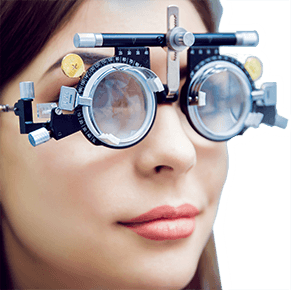What is astigmatism, and what are the correction options?

What is astigmatism?
Astigmatism is a type of refractive error caused by the irregularities in the shape of a person’s cornea. In this condition, the eye fails to focus the light equally on the retina leading to blurred or distorted vision. It can be present at the time of birth, or can develop gradually in life.
Astigmatism is a common eye condition which usually occurs with myopia (short-sightedness) or hyperopia (long-sightedness) and can be easily diagnosed with a simple eye exam.
Astigmatism is a refractive error and is not an eye disease or eye health issue.
Astigmatism is simply a problem with how the eye focuses light.
Astigmatism symptoms
Astigmatism usually causes vision to be blurred or distorted to some degree at all distances. Some of its symptoms are eye strain, headaches, squinting and eye irritation.
What causes astigmatism?
Astigmatism is usually caused by an irregularly shaped cornea. Instead of the cornea having a symmetrically round shape (like a football), it is shaped more like an egg (or rugby ball), with one meridian being significantly more curved than the meridian perpendicular to it.
(To understand what meridians are, think of the front of the eye like the face of a clock. A line connecting the 12 and 6 is one meridian; a line connecting the 3 and 9 is another.)
The steepest and flattest meridians of an eye with astigmatism are called the principal meridians.
In some cases, astigmatism is caused by the distortion of shape of the lens inside the eye. This is called lenticular astigmatism, to differentiate it from the more common corneal astigmatism.
It's important to schedule an eye exam for your child to avoid vision problems in school from uncorrected astigmatism.
3 types of astigmatism
There are three primary types of astigmatism:
Myopic astigmatism.
One or both principal meridians of the eye are short sighted. (If both meridians are short sighted, they are myopic in differing degree.)
Hyperopic astigmatism.
One or both principal meridians are long sighted. (If both are long sighted, they are hyperopic in differing degree.)
Mixed astigmatism.
One prinicipal meridian is short sighted, and the other is long sighted.
Astigmatism is also classified as regular or irregular. In regular astigmatism, the principal meridians are 90 degrees apart (perpendicular to each other). In irregular astigmatism, the principal meridians are not perpendicular.
Most astigmatism is regular corneal astigmatism, which gives the front surface of the eye an oval shape.
Irregular astigmatism can result from an eye injury that has caused scarring on the cornea, from certain types of eye surgery or from keratoconus, a disease that causes a gradual thinning of the cornea.
Astigmatism tests
Astigmatism is detected during a routine eye exam with the same instruments and techniques used for the detection of short-sightedness and long-sightedness.
Your optician can estimate the amount of astigmatism you have by shining a light into your eye while manually introducing a series of lenses between the light and your eye. This test is called retinoscopy.
Astigmatism correction options
Astigmatism can usually be corrected with glasses or contact lenses.
SEE RELATED: Contact lenses for astigmatism: Toric, GP and hybrid lenses
Refractive surgery is one of the less common astigmatism correction options, however, since it is a laser procedure that changes the shape of your eyes, it comes with risks associated with most surgeries.
Astigmatism should be treated as soon as possible. Once diagnosed, regular visits to an optician are required as astigmatism can fluctuate over time, making it necessary for prescriptions to be modified.
FIND AN OPTICIAN: if you're concerned about your vision, visit an optician near you.
Page published on Thursday, 27 June 2019






